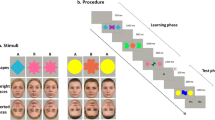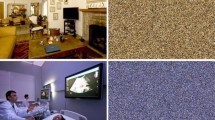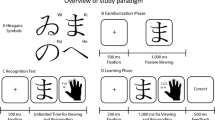Abstract
The learning-style theory of Autism Spectrum Disorders (ASD) (Qian, Lipkin, Frontiers in Human Neuroscience 5:77, 2011) states that ASD individuals differ from neurotypics in the way they learn and store information about the environment and its structure. ASD would rather adopt a lookup-table strategy (LUT: memorizing each experience), while neurotypics would favor an interpolation style (INT: extracting regularities to generalize). In a series of visual behavioral tasks, we tested this hypothesis in 20 neurotypical and 20 ASD adults. ASD participants had difficulties using the INT style when instructions were hidden but not when instructions were revealed. Rather than an inability to use rules, ASD would be characterized by a disinclination to generalize and infer such rules.




Similar content being viewed by others
Change history
10 May 2018
The original version of this article unfortunately contained a mistake in the article title
References
Alderson-Day, B., & McGonigle-Chalmers, M. (2011). Is it a bird? Is it a plane? Category use in problem-solving in children with autism spectrum disorders. Journal of Autism and Developmental Disorders, 41(5), 555–565. https://doi.org/10.1007/s10803-010-1077-9.
American Psychiatric Association. (2000). Diagnostic and statistical manual of mental disorders, (4th ed.). Washington, DC: American Psychiatric Association.
American Psychiatric Association. (2013). Diagnostic and statistical manual of mental disorders V, DSM-V. Washington, DC: American Psychiatric Association.
Asperger, H. (1944). Die ‘Autistischen Psychopathen’ im Kindesalter. Archiv für Psychiatrie und Nervenkrankheim, 117, 76–136.
Baez, S., & Ibanez, A. (2014). The effects of context processing on social cognition impairments in adults with Asperger’s syndrome. Frontiers in Neuroscience, 8, 270. https://doi.org/10.3389/fnins.2014.00270.
Baez, S., Rattazzi, A., Gonzalez-Gadea, M. L., Torralva, T., Vigliecca, N. S., Decety, J., et al. (2012). Integrating intention and context: Assessing social cognition in adults with Asperger syndrome. Frontiers in Human Neuroscience, 6, 302. https://doi.org/10.3389/fnhum.2012.00302.
Baron-Cohen, S., Wheelwright, S., Skinner, R., Martin, J., & Clubley, E. (2001). The autism-spectrum quotient (AQ): Evidence from Asperger syndrome/high-functioning autism, males and females, scientists and mathematicians. Journal of Autism and Developmental Disorders, 31(1), 5–17.
Bertone, A., Mottron, L., Jelenic, P., & Faubert, J. (2005). Enhanced and diminished visuo-spatial information processing in autism depends on stimulus complexity. Brain: A Journal of Neurology, 128(Pt 10), 2430–2441. https://doi.org/10.1093/brain/awh561.
Bott, L., Brock, J., Brockdorff, N., Boucher, J., & Lamberts, K. (2006). Perceptual similarity in autism. Quarterly Journal of Experimental Psychology (2006), 59(7), 1237–1254. https://doi.org/10.1080/02724980543000196.
Carmo, J. C., Souza, C., Gonçalves, F., Pinho, S., Filipe, C. N., & Lachmann, T. (2017). Effects of categorical representation on visuospatial working memory in autism spectrum disorder. Journal of Clinical and Experimental Neuropsychology, 39(2), 131–141. https://doi.org/10.1080/13803395.2016.1207754.
Church, B. A., Krauss, M. S., Lopata, C., Toomey, J. A., Thomeer, M. L., Coutinho, M. V., et al. (2010). Atypical categorization in children with high functioning autism spectrum disorder. Psychonomic Bulletin & Review, 17(6), 862–868. https://doi.org/10.3758/PBR.17.6.862.
Church, B. A., Rice, C. L., Dovgopoly, A., Lopata, C. J., Thomeer, M. L., Nelson, A., & Mercado, E. (2015). Learning, plasticity, and atypical generalization in children with autism. Psychonomic Bulletin & Review, 22(5), 1342–1348. https://doi.org/10.3758/s13423-014-0797-9.
Dawson, M., Mottron, L. (2008). Learning and memory: A comprehensive reference III cognitive psychology. In J. Byrne, & H.L. Roediger (Eds.) Learning in autism, (pp. 759–772). Oxford: Elsevier.
Dawson, M., Mottron, L., & Gernsbacher, M. A. (2005). Learning and memory: A comprehensive reference. In J. Byrne (Ed.) Learning in autism, vol. 2, (pp. 759–772). Oxford: Elsevier.
Fisher, A. V., Godwin, K. E., Matlen, B. J., & Unger, L. (2014). Development of category-based induction and semantic knowledge. Child Development. https://doi.org/10.1111/cdev.12277.
Friston, K. (2003). Learning and inference in the brain. Neural Networks: The Official Journal of the International Neural Network Society, 16(9), 1325–1352. https://doi.org/10.1016/j.neunet.2003.06.005.
Frith, U. (1991). Autism and Asperger syndrome. Cambridge: Cambridge University Press.
Froehlich, A. L., Anderson, J. S., Bigler, E. D., Miller, J. S., Lange, N. T., DuBray, M. B., et al. (2012). Intact prototype formation but impaired generalization in autism. Research in Autism Spectrum Disorders, 6(2), 921–930. https://doi.org/10.1016/j.rasd.2011.12.006.
Gastgeb, H. Z., Dundas, E. M., Minshew, N. J., & Strauss, M. S. (2012). Category formation in autism: Can individuals with autism form categories and prototypes of dot patterns? Journal of Autism and Developmental Disorders, 42(8), 1694–1704. https://doi.org/10.1007/s10803-011-1411-x.
Gastgeb, H. Z., & Strauss, M. S. (2012). Categorization in ASD: The role of typicality and development. Perspectives on Language Learning and Education, 19(2), 66–74. https://doi.org/10.1044/lle19.2.66.
Grandin, T. (1997). A personal perspective on autism. In D. J. Cohen & F. R. Volkmar (Eds.) Handbook of autism and pervasive developmental disorders, (pp. 1032–1042). Hoboken: Wiley.
Grossberg, S. (1999). The link between brain learning, attention, and consciousness. Consciousness and Cognition, 8(1), 1–44. https://doi.org/10.1006/ccog.1998.0372.
Kanner, L. (1943). Autistic disturbances of affective contact. Nervous Child, 2(3), 217–250.
Klinger, L. G., & Dawson, G. (2001). Prototype formation in autism. Development and Psychopathology, 13(1), 111–124.
Koldewyn, K., Jiang, Y. V., Weigelt, S., & Kanwisher, N. (2013). Global/local processing in autism: Not a disability, but a disinclination. Journal of Autism and Developmental Disorders, 43(10), 2329–2340. https://doi.org/10.1007/s10803-013-1777-z.
Lawson, R. P., Mathys, C., & Rees, G. (2017). Adults with autism overestimate the volatility of the sensory environment. Nature Neuroscience. https://doi.org/10.1038/nn.4615.
Le Couteur, A., Lord, C., & Rutter, M. (2003). The autism diagnostic interview-revised (ADI-R). Los Angeles: Western Psychological Services.
Lord, C., Risi, S., Lambrecht, L., Cook, E. H., Leventhal, B. L., DiLavore, P. C., et al. (2000). The autism diagnostic observation schedule-generic: A standard measure of social and communication deficits associated with the spectrum of autism. Journal of Autism and Developmental Disorders, 30(3), 205–223.
Marcus, G. F., Fernandes, K. J., & Johnson, S. P. (2007). Infant rule learning facilitated by speech. Psychological Science, 18(5), 387–391. https://doi.org/10.1111/j.1467-9280.2007.01910.x.
Ozonoff, S., & Miller, J. N. (1995). Teaching theory of mind: A new approach to social skills training for individuals with autism. Journal of Autism and Developmental Disorders, 25(4), 415–433. https://doi.org/10.1007/BF02179376.
Palmer, C. J., Lawson, R. P., & Hohwy, J. (2017). Bayesian approaches to autism: Towards volatility, action, and behavior. Psychological Bulletin. https://doi.org/10.1037/bul0000097.
Plaisted, K. C. (2001). Reduced generalization in autism: An alternative to weak central coherence. In J. A. Burack, T. Charman, N. Yirmiya & P. R. Zelazo (Eds.), The development of autism: Perspectives from theory and research (pp. 149–169). Mahwah, NJ: Lawrence Erlbaum Associates Publishers.
Qian, N., & Lipkin, R. M. (2011). A learning-style theory for understanding autistic behaviors. Frontiers in Human Neuroscience, 5, 77. https://doi.org/10.3389/fnhum.2011.00077.
Robic, S., Sonié, S., Fonlupt, P., Henaff, M.-A., Touil, N., Coricelli, G., et al. (2014). Decision-making in a changing world: A study in autism spectrum disorders. Journal of Autism and Developmental Disorders. https://doi.org/10.1007/s10803-014-2311-7.
Senju, A., Southgate, V., White, S., & Frith, U. (2009). Mindblind eyes: An absence of spontaneous theory of mind in Asperger syndrome. Science (New York, N.Y.), 325(5942), 883–885. https://doi.org/10.1126/science.1176170.
Sonié, S., Kassai, B., Pirat, E., Masson, S., Bain, P., Robinson, J., et al. (2011). French version of screening questionnaire for high-functioning autism or Asperger syndrome in adolescent: Autism Spectrum Quotient, Empathy Quotient and Systemizing Quotient. Protocol and questionnaire translation. Presse Médicale (Paris, France: 1983), 40(4 Pt 1), e181–e188. https://doi.org/10.1016/j.lpm.2010.07.016.
Soulières, I., Mottron, L., Giguère, G., & Larochelle, S. (2011). Category induction in autism: Slower, perhaps different, but certainly possible. Quarterly Journal of Experimental Psychology (2006), 64(2), 311–327. https://doi.org/10.1080/17470218.2010.492994.
Soulières, I., Mottron, L., Saumier, D., & Larochelle, S. (2007). Atypical categorical perception in autism: Autonomy of discrimination? Journal of Autism and Developmental Disorders, 37(3), 481–490. https://doi.org/10.1007/s10803-006-0172-4.
Suzanne Scherf, K., Behrmann, M., Minshew, N., & Luna, B. (2008). Atypical development of face and greeble recognition in autism. Journal of Child Psychology and Psychiatry, 49(8), 838–847. https://doi.org/10.1111/j.1469-7610.2008.01903.x.
Van der Hallen, R., Evers, K., Boets, B., Steyaert, J., Noens, I., & Wagemans, J. (2016). Visual search in ASD: Instructed versus spontaneous local and global processing. Journal of Autism and Developmental Disorders, 46(9), 3023–3036. https://doi.org/10.1007/s10803-016-2826-1.
Van der Hallen, R., Evers, K., Brewaeys, K., Van den Noortgate, W., & Wagemans, J. (2015). Global processing takes time: A meta-analysis on local-global visual processing in ASD. Psychological Bulletin, 141(3), 549–573. https://doi.org/10.1037/bul0000004.
Vladusich, T., Olu-Lafe, O., Kim, D.-S., Tager-Flusberg, H., & Grossberg, S. (2010). Prototypical category learning in high-functioning autism. Autism Research: Official Journal of the International Society for Autism Research, 3(5), 226–236. https://doi.org/10.1002/aur.148.
Weston, D. R., & Turiel, E. (1980). Act–rule relations: Children’s concepts of social rules. Developmental Psychology, 16(5), 417–424. https://doi.org/10.1037/0012-1649.16.5.417.
White, S. J., Burgess, P. W., & Hill, E. L. (2009). Impairments on “open-ended” executive function tests in autism. Autism Research: Official Journal of the International Society for Autism Research, 2(3), 138–147. https://doi.org/10.1002/aur.78.
Acknowledgments
We would like to thank all of the participants for their precious time, participation, feedbacks on the tasks, and enriching conversations. We also thank Nathalie Touil and Lucie Hannequin for taking care of the WAIS assessments of most of the participants, and for the interesting discussions about WAIS interpretation.
Funding
This study was supported by a Scientific Research Council grant from the Vinatier Hospital Center, and was performed within the framework of the LABEX CORTEX (ANR-11-LABX-0042) of Université de Lyon, within the program “Investissements d’Avenir” (ANR-11-IDEX-0007) operated by the French National Research Agency (ANR).
Author information
Authors and Affiliations
Contributions
Paradigms were designed by LAST, MAH, JM and CS, participants were recruited by SS, data collection and analyses were performed by LAST, the article was written by LAST, JM and CS. All authors read and approved the final manuscript.
Corresponding author
Ethics declarations
Conflict of interest
All authors declare that they have no conflict of interest to disclose.
Ethical Approval
All procedures performed in this study were in accordance with the standards of the French ethical guidelines and with the 1964 Helsinki declaration and its later amendments or comparable ethical standards. Approval was obtained from the local ethics committee (French South East IV Committee for the Protection of Persons).
Informed Consent
Participants gave their written consent beforehand.
Rights and permissions
About this article
Cite this article
Sapey-Triomphe, LA., Sonié, S., Hénaff, MA. et al. Adults with Autism Tend to Undermine the Hidden Environmental Structure: Evidence from a Visual Associative Learning Task. J Autism Dev Disord 48, 3061–3074 (2018). https://doi.org/10.1007/s10803-018-3574-1
Published:
Issue Date:
DOI: https://doi.org/10.1007/s10803-018-3574-1




